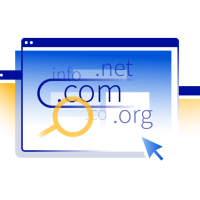What is a URL?
Also referred to as a web address, a uniform resource locator (URL) is made up of different elements – such as a domain name – that instructs the web browser where and how it can access the desired resource that the user wants to view or retrieve.

URL definition
What is a URL address? It all begins with the IP address, a long string of numbers and letters. This represents a unique address for any and every device – think server or computer – on the net. For instance, OVHcloud’s IP address is 54.39.46.56. However, expecting users to remember such a long string is not practical.
That’s why domain names were introduced in 1983 to help create web addresses – URLs – that can be easily recalled and entered by users. However, domain names only make up part of a URL. For instance, the full URL for OVHcloud is https://www.ovhcloud.com/. But what is URL anatomy? What does each element of a URL mean and what does it actually do?
What is a URL’s protocol?
Standing for Hypertext Transfer Protocol, ‘http://' is the protocol that underpins the whole of the world wide web. When you visit any web page, the protocol enables computers to talk to each other so your web experience is created in real-time. The process works like this:
- You enter the web page’s uniform resource locator into your browser, including the HTTP at the start of the URL.
- When you press ‘Enter’, your browser sends the HTTP request.
- This request is received by the uniform resource locator’s web server that hosts the website you want to view.
- The server executes your request, collecting all data files related to the web page.
- The server sends these files back to your browser via HTTP, which in turn uses them to create the web page onscreen.
- Each time you make a different request – such as navigating to another page/uniform resource locator on the website – the process starts up all over again.
What’s the difference between http and https?
You will have noticed OVHcloud’s uniform resource locator begins with ‘https’, not ‘http’. That extra ‘S’ stands for ‘Secure’, i.e., Hypertext Transfer Protocol Secure. Using a Secure Sockets Layer (SSL) certificate, this means any data that is transported via HTTPS is secured using encryption. Our recommendation? If a commercial site doesn’t use HTTPS, it should be avoided as it hasn’t adopted the most basic of web security measures.
What other protocols are available?
Uniform resource locator protocols aren’t all HTTP-based. For instance, for direct file transferring between devices on a network, FTP (File Transfer Protocol) is used, which offers useful feature sets including directory listings and user authentication. A variant on this, TFTP (Trivial File Transfer Protocol) is deployed for more simple ‘lightweight’ file transfers that don’t need all the whistles and bells of FTP.
What is a URL’s subdomain?
This is ‘www’ aka the ‘world wide web’, a specific subdomain that signposts the website you wish to visit can be accessed via the internet using HTTP. In nearly all cases, you won’t need to type this or HTTP in. For instance, if you just type the abbreviated URL 'OVHcloud.com' into your browser, you will still be taken to our website.
Most importantly, the subdomain can be changed for another subdomain on the website. For instance, OVHcloud uses the https://blog.ovhcloud.com/ uniform resource locator for our blogs page and https://help.ovhcloud.com/ for help and support.
What is a URL’s domain name/top-level domain?
This is the IP address but in a massively simplified form – the site’s domain name is followed by the domain extension or top level domain (TLD), i.e., OVHcloud.com. A TLD typically denotes what kind of organisation the URL belongs to or where it is based. Several types are available to purchase through a domain registrar such as OVHcloud. For instance:
Generic top-level domain (gTLD)
A gTLD can be deployed to promote general types of websites, services or products – and are not associated with any specific country or locale:
.com (typically denotes a commercial company)
.org (denotes a non-profit organisation)
.info (denotes an informational website)
Country code top-level domains (ccTLD)
A ccTLD enables organisations to ‘label’ website addresses with a country-specific two-character identifier code. For example:
.cn (China)
.de (Germany)
.uk (United Kingdom)
.nl (Netherlands)
.br (Brazil)
Sponsored top-level domain (sTLD)
These are only available to organisations and businesses that meet sponsor-defined requirements:
.edu (can only by used by educational institutions)
.gov (can only be used by the US government)
.mil (can only be used by the US military)
.aero (can only be used by the aviation industry)
What is a URL’s path to the resource
This offers your browser additional details – or paths – for getting to the exact page you want to visit, for example, www.ovhcloud.com/en-gb/web-hosting. In this example, the path is denoted by the forward slash – the ‘/en-gb’ path directing the English-speaking user to the UK language website. An additional path is added at the end of this via ‘/web-hosting‘ to take you to the our web hosting offer in English.
Other URL elements
What is a URL link parameter
These are used for creating single or multiple query strings. The query is triggered with a question mark at the end of the uniform resource locator. Depending on how you use them, a website’s behaviour can be customised. For instance, ecommerce sites can use filtering parameters to create categories for product types based on criteria such as price.
What is an absolute uniform resource locator?
This is the entire web address that features the protocol, the subdomain, the domain name/TLD and paths to a specific resource, i.e., www.ovhcloud.com/en-gb/web-hosting.
What is an relative uniform resource locator?
This only provides a partial address to a resource. Helping to simplify website navigation, it is typically deployed once you’re on the website, using the base URL automatically before adding the relative URL.
How to source a URL
This is done via an accredited ICANN (Internet Corporation for Assigned Names and Numbers) registrar. For instance, use OVHcloud’s search service to find your TLD by entering your desired domain name. This enables you to see what TLDs are available and what the costs per year will be. If you wish to proceed with your purchase, simply pay and we take care of the rest. You now have an official URL.
If the name/desired TLD has already been taken, OVHcloud can approach the existing owner to try and secure the name for a fee. If they agree to sell, we manage the entire transaction with the seller via a trusted third party and organise the transfer transparently.
OVHcloud and URL
We offer the simplest and most direct way to build your website, access versatile web hosting options, and secure the domain name that’s right for you and your business at no cost. Also use our powerful tools to find the perfect domain name, checking to see if it’s available to purchase.

Get a free domain name
We offer a free domain name for one year when you subscribe to any OVHcloud web hosting plan. You can find your domain with over 800 extensions to choose from so you can define your true digital identity. Our extensions include: com, net, biz, info, org, name, fr, re, eu, be, es, it, de, at, co.uk, me.uk, org.uk, nl, us, ca, cz, ch, in, lt, dk, pm, so, se, yt, tf, wf, pt, pl, ovh, and xyz.


